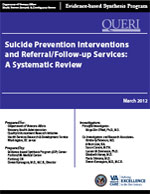
|
Principal Investigator:
Maya Elin O'Neil, Ph.D., M.S. Evidence-based Synthesis Program (ESP) Center Portland VA Medical Center Portland, OR; Department of Veterans Affairs; March 2012 |
Download PDF: Complete Report, Executive Summary, Report, Appendices
Suicide is the tenth leading cause of death in the United States (US), with nearly 100 suicides occurring each day and over 36,000 dying by suicide each year. Among Veterans and current military, suicide is a national public health concern. Recent estimates suggest current or former military represent 20 percent of all known suicides in the US and the rate of suicides among Veterans utilizing Veterans Health Administration (VHA) services is estimated to be higher than the general population. The enormity of the problem has led to several major public health initiatives and a growth in research funding for suicide prevention.
Despite recent suicide prevention efforts, the suicide rate in the US has changed relatively little over the past 100 years. The body of research on suicide prevention approaches has been reviewed previously by Gaynes and colleagues, and Mann and colleagues,and recent, similar work exists in the form of draft self-harm guidelines from the National Institute for Health and Clinical Excellence (NICE) in 2011. As requested by the Veterans Affairs (VA)/Department of Defense (DoD) Evidence Based Practice Working Group (EBPWG) on suicide prevention, we examined recent research on suicidal self-directed violence as defined by Crosby et al. 2011. We update the work of Gaynes et al. and Mann et al. by systematically reviewing relevant literature that was not included in either report, and was published in 2005 through November 18, 2011. Though the focus of the report is on suicide prevention, we include as outcomes any type of suicidal self-directed violence, defined as "Behavior that is self-directed and deliberately results in injury or the potential for injury to oneself. There is evidence, whether implicit or explicit, of suicidal intent."
The key questions were: